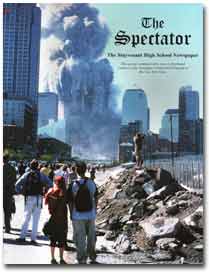It was only the fifth day of school, and English teacher Holly Epstein Ojalvo ’92 was still trying to learn the names of all of her 165 students at Stuyvesant High School, just four blocks from the World Trade Center. She had just started her second year as a teacher at the school. With 3,000 students, “Stuyvesant is larger than Lafayette,” jokes the English graduate.
Ojalvo was on the sixth floor of the ten-story building when the first plane hit. “I heard it and felt it,” she says. “It sounded like a bomb or an explosion. I looked down on the street to see what was happening. My chairman turned on the television and we heard a plane had hit the World Trade Center. I looked up and saw a horrifying sight. It gave me goosebumps.” She went up to the tenth floor to teach her first class, in a room facing away from the WTC.
“I felt the second plane hit,” she says. “Some kids started crying because they had relatives in the WTC. The school was ‘locked down’ so no one could leave. I had a TV in the room, so we turned it on since there was no way the kids could focus on English. We heard the President (Bush) speak. I was terrified, but I had a room of 34 kids in my care. We didn’t know what was happening. We saw people streaming away and emergency vehicles going towards the towers. All those guys (emergency workers) died. I can’t stop thinking about them.
“When the first tower fell, the whole building rolled-it felt like an earthquake,” Ojalvo continues. “The lights flickered. We couldn’t see the WTC from the room, and it was terrifying not knowing what was going on.”
She was in a stairwell helping evacuate students when the second tower fell. “When I went out all I could see was brown smoke,” Ojalvo says. “I didn’t see the towers weren’t there. A lot of kids didn’t know where to go. So teachers walked north with kids. I walked with about 20 kids to Brooklyn. It was an odyssey. It was surreal. There were no cars; the bridges were closed because they might be a target.”
Ojalvo lives right across the river from Manhattan and arrived home five hours later to find everything covered in ash and filled with smoke. “We had to cover our faces with wet rags to go out,” she says.
She had just started her new assignment in September as faculty adviser to the biweekly student newspaper, The Spectator. With Stuyvesant being used as an emergency center, the students were relocated to Brooklyn Polytechnic High School, going to school in the afternoons. The students wanted to publish an issue of the paper, so they begged and borrowed space, phones and computers from businesses to work. “We worked everywhere, including my house until 1 a.m.,” she says. “It was the kids’ idea to make this issue a magazine. They felt the youth voice was missing from the discourse. They also had the idea of having The (New York) Times publish it. The Times agreed to distribute it as part of their newspaper in education program, but said we had to print it. So I became a fundraiser, spending all my time I wasn’t in class calling and emailing anyone I thought could help the kids, trying to raise $70,000 to print it. Eventually R.R. Donnelley agreed to donate the printing for us and StoraEnso North America donated the paper.”
An initial printing of 10,000 copies of the special issue of The Spectator was distributed Oct. 2 to the Stuyvesant school community. Another 850,000 copies of a slightly updated version of the paper were printed and distributed as part of The Times on Nov. 20. “I can’t describe how it felt to see the final printed piece,” Ojalvo says. “I almost swooned when I saw it on the newsstand. The kids were so excited to see their work being read in the subway.” The magazine has received much praise as well as extensive media attention. Manhattan Congressman Jerrold Nadler requested copies to distribute in Washington to all congressmen and senators.
The students are now back in their own school, but the fires are still burning. “Until recently we could still smell an acrid stench in the school,” Ojalvo says. “The barge carrying debris from the site to Staten Island loads right by the school. But the kids are resilient. They are looking forward. I think the paper gives them an outlet to express themselves.
“They’re great kids,” she says. “They’re the reason I do this.”
To see a copy of The Spectator, go to www.nytimes.com/learning/terrorism

